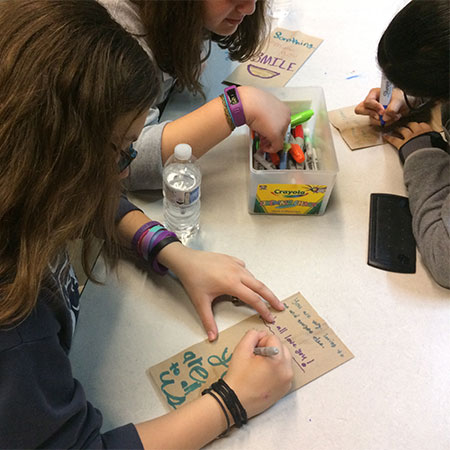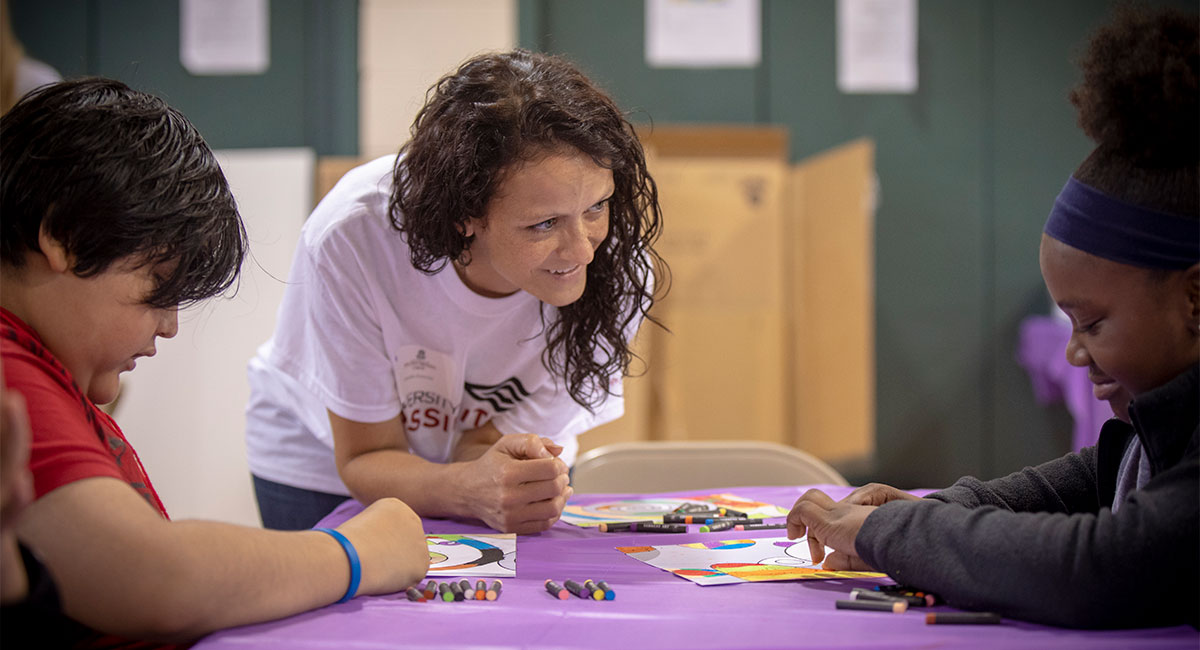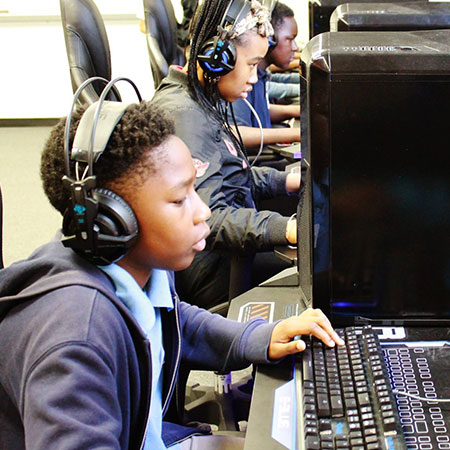Pathway to the future
University of Possibilities gives SC students a college map
Posted on: July 19, 2018; Updated on: July 19, 2018
By Megan Sexton, msexton@mailbox.sc.edu, 803-777-1421
Anita Watts’ first college experience was on the campus of USC Lancaster, where she earned college credit while she was still in high school. She later went on to take graduate classes in education administration on the campus, before earning her master’s degree at USC Columbia.
Watts, now principal of A.R. Rucker Middle School in Lancaster, was back on the USC Lancaster campus in May, this time with a group of sixth graders. The middle-schoolers toured the campus with student guides, watched nursing students run through a simulated medical emergency, learned about exercise science research, performed a little improv on the campus stage and picked up some Lancer swag in the bookstore.
The students were participating in a campus experience tour that is part of the University of Possibilities, a University of South Carolina program designed to prepare sixth through 12th-graders and their parents for college. Starting at age 12, program participants and their parents receive customized guidance as they navigate the maze of college preparation. The program, designed to meet the needs of low-income, first-generation and underrepresented students, extends beyond high school to offer additional support to participants who enroll at a USC system campus.

Middle school students tour the campus and take part in hands-on activities at USC Lancaster as part of the University of Possibilities program.
“We need them to get exposure to let them know that anything is possible,” Watts says. “A lot of this will help them see how important education is and that it’s in their reach.”
This spring, University of Possibilities tours were held at three campuses of Palmetto College — Lancaster, Union and Sumter. There, students got a glimpse of what it is like to be a college student, and learned the importance of preparing now for success beyond high school. The program reinforces the message that higher education is an important catalyst for economic mobility, particularly critical in South Carolina.
“This is about possibilities,” says Susan Elkins, the chancellor of Palmetto College who spoke to the middle school students as they began their day. “The University of Possibilities program is going to help you think about what you want to do when you get older. The program will help you know that college is for you.”
That’s an especially important message in some parts of South Carolina, which lag behind the nation and the state in the number of residents with college degrees. Michael Sonntag, the campus dean at USC Sumter, told the middle school students that he had something in common with many of them.
“I am a first-generation college student,” he told the students from Chestnut Oaks Middle School. “I was terrified when I first got to college. Then I realized there were other kids just like me. When you go to college, there will be people on the campus who are just like you. Our campus welcomes everyone. This is your university. All you’ve got to do is come ready to learn.”
The program provides a 12-month curriculum, and partners with schools for limited in-class instruction that makes it easy to keep the conversation about going to college in front of students through quick, consistent activities. Parents receive resources and information to help families understand the necessary steps for college readiness. University representatives met with parents before the college visits, explaining the University of Possibilities program and the importance of a college education. The pilot program this spring exposed 630 middle school students, 950 parents and 20 school administrators to this new USC outreach initiative.
“University of Possibilities is designed to demystify the process, and provides an extensive and tailored framework for addressing every aspect of pursuing education after high school; not only being college ready, but also how to successfully graduate from college,” says Derrick Huggins, USC’s vice president for facilities and operations.
‘We don’t want to be too late’
Lori Murphy says when her daughter, Samantha Chasteen, first heard about the program at USC Union, her response was, “Mom, really? I’m in sixth grade.”
“But I told her, ‘Before you realize it you’ll be in high school,’” says Murphy, who attended the session at USC Union with her daughter. “I was excited to be part of this and watch her and watch all of them. I told her, ‘You understand, this is the University of South Carolina.’”
Higher education leaders are quick to point out that sixth grade isn’t too early to start planning for college. Throughout the day at each campus, administrators, professors and others told students now is the time to start thinking about the classes and grades they will need to make college a reality.
Walt Collins, the campus dean at USC Lancaster, and John Catalano, the dean at USC Union, say the program targets a group that might not yet be thinking about college — but should be.
“We need to talk with them about their eventual careers. To ask them: ‘What do you like to do? To get there, you need to have the education. You have to prepare and you have to go to school,’” Collins says.
“If we wait until 10th grade, we may have missed the opportunity. We don’t want to be too late,” says Catalano. “That’s why we need to get to them in sixth grade.”
USC Union enrolled 903 students in fall 2017 and expects more than 1,000 in August from 81 high schools in South Carolina. When talking to middle school students, he stressed the size and scope of the USC system.
“They are going to the University of South Carolina. This is USC. A lot of people don’t understand that, but every single course, every transcript comes from USC. We’ll make that pitch and we’ll explain it early,” Catalano says. “Why do we have them here in sixth grade? Because now is the time to start thinking about college.”
Hugh Mobley, a member of the university’s Board of Trustees representing the Lancaster area, attended the program at USC Lancaster. He, too, stressed the importance of getting students in the higher education pipeline as early as possible.
“There’s a big push in South Carolina for all South Carolinians to have the opportunity to get a higher education degree. And awareness is a lot of it. This is where it’s got to start,” Mobley says. “We need to get students as soon as we can and let it be known that it’s an option.”
Ron Cox, academic dean at USC Lancaster and a history professor, told students that more than 17 percent of people in Lancaster County lack a high school diploma, while 27 percent have a bachelor’s degree or higher. He got their attention when he told them the average worker with less than a high school degree will earn $973,000 in a lifetime, while a high school graduate will earn $1.3 million. A college graduate earns $2.26 million in a lifetime of work.
“When you are investing in your education, you are investing in yourself. But you aren’t going to get here if you don’t start working right now,” Cox says.

Planting the seeds
During the campus visits, college instructors spoke with the middle-schoolers who rotated through stations, giving them a taste of what to expect when they attend college.
In Randy Lowell’s psychology lab at USC Union, sixth-graders had the opportunity to participate in eye-tracking research

As part of the University of Possibilities program, middle school students visit Palmetto College campuses, including USC Sumter, to get a glimpse of what it is like to be a college student.
“You plant seeds in middle school and let them know what’s available. I didn’t know this part of psychology existed until I was a junior in college,” says Lowell, who teaches cognitive psychology, including the study of language, perception and memory. “One of them said he thought college was way more fun than middle school. We want them to keep that mentality.”
Liz Easley, who teaches exercise science at USC Lancaster and is one of the sponsors of the school’s research club, says introducing middle school students to the opportunities, including undergraduate research, can inspire them to start thinking about college. Easley and some of her students at USC Lancaster met with the middle-schoolers, showing them examples of research.
“The earlier we target K-12 students, the earlier they understand that ‘Maybe research is something I could do,’” she says. “Our mission is to get them involved early.”
The college students, not too far removed from middle school themselves, thought University of Possibilities was hitting students at just the right time.
“When I was in sixth grade I had no idea what a GPA was,” says Mary Scarborough, the student government association president at USC Union who was leading a group of Sims Middle School students on a campus tour. “Dean Catalano talked to them, so they could hear about the great opportunities they have. It should help them get prepared for what they need to do in high school.”
The next step
USC’s Huggins remembers back to 1984, when a couple of his friends graduated from high school with strong grades and in the top 10 percent of their class, yet didn’t go to college.
“It all came down to resources or that they didn’t know the navigational procedure. Thirty years later, some of those same friends are now calling to make sure their kids get to college,” he says. “The navigation process is very important. You can’t start too late, and we have to educate the parents as well.”
Huggins has taken a lead role in University of Possibilities, after starting work on a similar program in 2009-10. He believes the initiative has the potential to send more South Carolinians to college, thus improving the state’s economic indicators. Studies show South Carolina residents have just a 4.4 percent chance of rising to a higher income level, one of the lowest rates in the country.
“Now the hard work continues. This is not just a ‘feel good’ program. We are not selling a pipe dream,” Huggins said. “Now we roll up our sleeves and keep working with the communities.”
Over the summer, the program’s scope has expanded to include a parent curriculum along with regular email communication with college-prep tips and learning activities to families who enrolled this spring. In the fall, campus experience tours will begin at USC Salkehatchie, pulling students from the Allendale—Jasper area. Also this fall, the year-round student curriculum will roll out to new schools in the state, along with community events, new parent programming, 11th- and 12th-grade tours, and a host of new sixth graders who will be invited to enroll in the program.
Maggie Wright, principal at Chestnut Oaks Middle School in Sumter County, says the session at USC Sumter helped her students start thinking about life beyond high school.
“Our students come from low-income families and this program can really broaden their horizons and let them know that there are people willing to invest in them,” Wright says. “I want our students to start dreaming right now.”